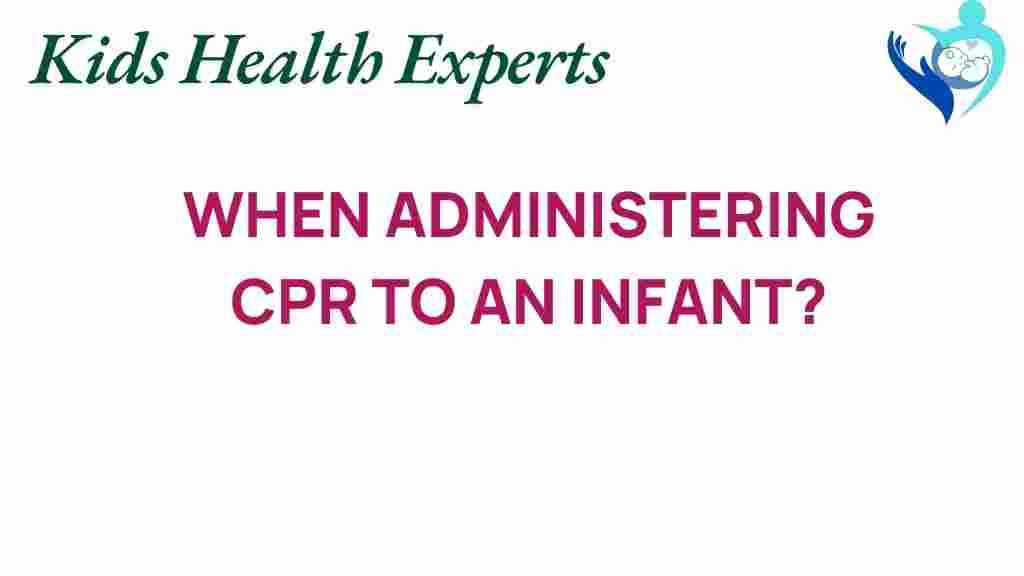When to Administer CPR to an Infant: A Lifesaving Skill for Every Parent
Cardiopulmonary resuscitation (CPR) is a crucial skill that can make a significant difference in emergency situations, especially for infants. Understanding when and how to administer CPR can be a lifesaving technique that every caregiver should master. This article will guide you through the essential moments when CPR should be performed on an infant, providing vital information on infant health, first aid practices, and parental guidance.
Understanding CPR for Infants
Infants, defined as children under the age of one, are particularly vulnerable to different types of emergencies, including choking and cardiac arrest. CPR for infants involves specific techniques that differ from those used for adults or older children. Recognizing the signs of emergencies and being prepared to act can save lives.
Key Situations Requiring CPR for Infants
There are several critical moments when CPR may be necessary for an infant:
- Unresponsive Infant: If your infant is unresponsive and not breathing, immediate CPR is required.
- Choking: If an infant is unable to breathe due to choking, you may need to perform back blows and chest thrusts before starting CPR.
- Severe Allergic Reaction: Anaphylaxis can cause airway obstructions, requiring CPR if the infant becomes unresponsive.
- Near Drowning: If an infant has been submerged in water and is not breathing, CPR must be started immediately.
- Sudden Infant Death Syndrome (SIDS): While SIDS cannot be prevented, if you find an unresponsive infant, check for breathing and pulse and begin CPR if necessary.
How to Administer CPR to an Infant
Knowing the correct procedure for infant CPR is essential. Here’s a step-by-step guide:
Step 1: Assess the Situation
Before administering CPR, ensure the scene is safe. Check for responsiveness:
- Gently tap the infant and shout, “Are you okay?”
- If there is no response, proceed with the next steps.
Step 2: Call for Help
In any emergency, calling for help is crucial. If you are alone, call emergency services immediately before starting CPR. If someone is with you, ask them to call while you begin the resuscitation process.
Step 3: Open the Airway
To open the airway for an infant:
- Place the infant on a flat surface.
- Gently tilt the head back by placing one hand on the forehead and two fingers of the other hand under the chin to lift it slightly.
Step 4: Check for Breathing
Observe for normal breathing:
- Look for chest movement.
- Listen for breath sounds.
- Feel for airflow from the infant’s mouth.
If the infant is not breathing or only gasping, begin CPR.
Step 5: Perform Chest Compressions
For chest compressions:
- Use two fingers to compress the chest just below the nipple line.
- Press down at least 1.5 inches deep at a rate of 100-120 compressions per minute.
- Allow the chest to fully recoil between compressions.
Step 6: Deliver Rescue Breaths
After 30 compressions, give rescue breaths:
- Seal your lips over the infant’s mouth and nose.
- Provide two gentle breaths, each lasting about 1 second, watching for the chest to rise.
- Continue with a cycle of 30 compressions followed by 2 breaths.
Step 7: Continue Until Help Arrives
Continue performing CPR until emergency responders arrive or the infant shows signs of life, such as breathing or movement.
Troubleshooting Tips for CPR on Infants
While administering CPR, various challenges may arise. Here are some troubleshooting tips:
- If the infant is choking: Before starting CPR, attempt to clear the airway using back blows and chest thrusts.
- If you are unsure about your technique: Focus on chest compressions, as they are crucial for maintaining blood flow.
- If you are alone: If you cannot call 911 before starting CPR, perform CPR for about 2 minutes before calling.
Importance of Pediatric Care and Infant Health
Regular pediatric care is essential for maintaining infant health. Routine check-ups can help identify potential health issues before they become emergencies. Parents should also be educated on recognizing signs of distress in their infants, as early intervention can prevent situations requiring CPR.
Parental Guidance on CPR and First Aid
Parents are encouraged to take certified CPR and first aid courses. These courses provide hands-on training and ensure that caregivers are prepared for emergencies. Many organizations, such as the American Heart Association and the Red Cross, offer courses specifically tailored for CPR in infants.
Moreover, parents should keep emergency numbers readily accessible and ensure that all caregivers, including babysitters and grandparents, are trained in CPR and first aid.
Conclusion
Knowing when and how to administer CPR to an infant is a vital skill for every parent and caregiver. In moments of crisis, acting quickly and confidently can mean the difference between life and death. By familiarizing yourself with the proper techniques and being prepared for emergencies, you can help safeguard your infant’s health. Remember, continuous practice and education in lifesaving techniques are essential for effective response during emergencies.
For more information on CPR training and infant health, visit this resource. Stay informed and prepared to protect your loved ones.
For additional insights on pediatric care, check out this article on infant health and safety.
This article is in the category Care and created by KidsHealthExperts Team
